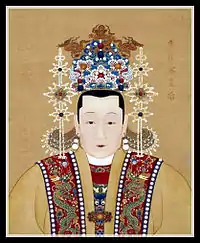Empress Qian
Empress Qian (1426–1468) was a Chinese Empress consort during the Ming Dynasty, married to the Zhengtong Emperor. She was addressed formally as Empress Xiaozhuangrui (Chinese: 孝庄睿皇后)
| Empress Qian | |||||
|---|---|---|---|---|---|
 Empress Qian | |||||
| Empress Consort of Ming China | |||||
| Reign | 8 June 1442– 1 September 1449 | ||||
| Predecessor | Empress Dowager Xiaoyi | ||||
| Successor | Empress Wang | ||||
| Retired Empress Consort of the Ming dynasty | |||||
| Reign | 1 September 1449 – 11 February 1457 | ||||
| Empress Consort of Ming China | |||||
| Reign | 11 February 1457 – 23 February 1464 | ||||
| Predecessor | Empress Suxiao | ||||
| Successor | Empress Wu | ||||
| Born | 1426 Haizhou 海州 | ||||
| Died | 1468 (aged 41–42) | ||||
| Burial | |||||
| Spouse | Emperor Yingzong of Ming | ||||
| |||||
Life
There is no record of Empress Qian's birth name, other than that she was a member of the clan Qian (Chinese: 錢), She married the Zhengtong Emperor on 8 June 1442. She became his primary consort and empress. [1]
Empress
In 1449, the Zhengtong Emperor was captured after the Battle of Tumu and his captors demanded a ransom, which Empress Qian and her mother-in-law promptly raised.[2] The ransom was rejected in favour of holding on to the Zhengtong Emperor as hostage, which prompted the court to assign him the status of retired emperor and name his half-brother Zhu Qiyu emperor.[3] Empress Qian was moved from the court to a separate palace to allow Empress Wang to take the title of Empress Consort.[4]
When her spouse was returned by the Mongols, arriving in Beijing on 19 September 1450, Empress Qian joined him under house arrest in a guarded section of the Imperial City.[5][6] When her spouse's only son, the future Chenghua Emperor, was deposed as heir apparent in 1452, he was sent to live with Empress Qian in conditions of physical hardship.[7] In 1457, a coup-d'etat put her spouse back on the imperial throne as the Tianshun Emperor, reinstating Empress Qian as the empress consort.[8]
Empress Dowager
Empress Qian had no children, and when the Zhengtong Emperor died in 1464, he was succeeded by the Chenghua Emperor. She became involved in a conflict with Empress Xiaosu, the biological mother of the new emperor. As the mother of the emperor, Empress Xiaosu demanded the same title as Qian: that of empress dowager.[9] Xiaosu pointed out that she was the mother of the emperor while Qian was childless, while Qian demanded the title pointing to her loyalty to the late emperor, whose house arrest she had shared.[10] The emperor was unable to solve the conflict to the satisfaction of both parties, but granted the title of empress dowager to both, though Qian's formal title acknowledged her higher rank and precedence in court proceedings.[9]
Burial
Empress Dowager Qian died in 1468 and was interred at Yu ling in the Ming tomb complex near Beijing. The Tianshun Emperor specifically stated that she should only be buried next to him, 'after a thousand years of long life.'[11]
References
Notes
- Twitchett (1988), p. 307.
- Twitchett (1988), p. 325.
- Twitchett (1988), p. 326.
- Twitchett (1988), p. 329.
- Twitchett (1988), p. 330.
- Mote (1988), p. 344.
- Mote (1988), p. 345.
- Twitchett (1988), p. 339.
- Mote (1988), p. 346.
- Carington (1976).
- History of Ming (1739). 英宗大漸,遺命曰:“錢皇后千秋萬歲後,與朕同葬。”
Works cited
- Carington, Goodrich L.; Fang, Chaoying, eds. (1976). Dictionary of Ming Biography, 1368-1644. 2. New York: Columbia University Press. ISBN 023103833X.
- Zhang Tingyu, ed. (1739). "《明史》卷一百十三 列传第一" [History of Ming, Volume 113, Historical Biography 1]. Lishichunqiu Net (in Chinese). Lishi Chunqiu. Retrieved 5 February 2017.
- Mote, Frederick W. (1988). "The Ch'eng-hua and Hung-chih Reigns, 1465-1505". In Frederick W. Mote; Denis C. Twitchett (eds.). The Ming Dynasty, 1368–1644, Part 1. The Cambridge History of China. 7. Cambridge: Cambridge University Press. pp. 343–402. doi:10.1017/CHOL9780521243322.008. ISBN 9781139054751.
- Twitchett, Denis C. (1988). "The Cheng-tung, Ching-t'ai, and T'ien-shun Reigns, 1436-1464". In Frederick W. Mote; Denis C. Twitchett (eds.). The Ming Dynasty, 1368–1644, Part 1. The Cambridge History of China. 7. Cambridge: Cambridge University Press. pp. 305–342. doi:10.1017/CHOL9780521243322. ISBN 9781139054751.
| Chinese royalty | ||
|---|---|---|
| Preceded by Empress Xiaogongzhang |
Empress of China 1442–1449 |
Succeeded by Empress Xiaoyuanjing |
| Chinese royalty | ||
| Preceded by Empress Suxiao |
Empress of China 1457–1464 |
Succeeded by Empress Wu (Ming dynasty) |